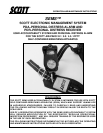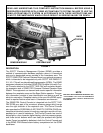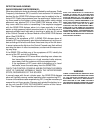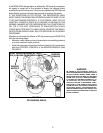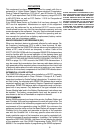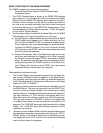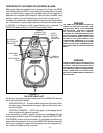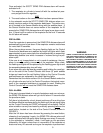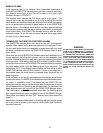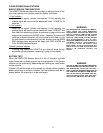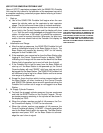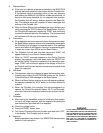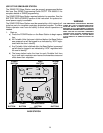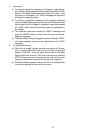7
BASIC FUNCTIONS OF THE SEMS EQUIPMENT
The SEMS equipment has two primary functions:
· Personal Alert Safety System (PASS) Distress Alarm
· Evacuation Signal
1. The PASS Distress Alarm is joined to the SEMS PDA distress
alarm operation. The Portable Unit will send a signal to the Base
Station when the SEMS PDA distress alarm goes into full alarm.
Activation of the full alarm can be either by manual activation of
the user or by automatic activation from lack of user movement
for the time period set on the SEMS PDA distress alarm. Once
acknowledged by the Base Station operator, “PASS” will appear
on the Control Console display.
2. The Evacuation Signal is sent from the Base Station to the SEMS
PDA Portable Unit. It can be handled one of two ways:
a) All-Call Signal: The Base Station will send a signal to all SEMS
PDA Portable Units logged on to it. When received, the Con-
trol Console will display “EVAC” and sound an audible signal.
Every respirator user must acknowledge this signal by press-
ing
twice
the RESET button on the Control Console. Display
will continue to read “EVAC” until user leaves hazardous area
and shuts down the respirator.
b) Selective Evacuation Alarm The Base Station will send a sig-
nal to only one individual unit logged on to it. When received,
the Control Console will display “EVAC” and sound an audible
alarm. The selected respirator user must acknowledge this sig-
nal by pressing
twice
the RESET button on the Control Con-
sole. Display will continue to read “EVAC” until user leaves
hazardous area and shuts down the respirator.
Other additional functions include:
1. The Contact Signal is an automatic signal sent by the Base Sta-
tion to every Portable Unit that is logged in to the Base Station.
Any respirator user who does not return an acknowledgment to
the Contact Signal within 120 seconds will be shown on the Base
Station as “OUT OF RANGE.”
2. Air supply cylinder levels are monitored by the Portable Unit and
the Base Station. The user can press and hold the RESET but-
ton at any time for a digital display of the remaining air supply
cylinder pressure. The approximate cylinder pressure is displayed.
The user receives a “½ AIR” warning in the display with an au-
dible alarm when the cylinder reaches one-half of full pressure.
The user also receives a “LOW AIR” warning in the display with
an audible alarm when the cylinder reaches one quarter of full
pressure. The “LOW AIR” warning is also transmitted to the Base
Station. The “LOW AIR” alarm will continue to operate until the
respirator is shut down.
3. Users can inform the Base Station that they are withdrawing from
the hazardous atmosphere by pressing and holding the “WITH-
DRAW” button on the Control Console for at least two seconds.
The display will read “W–D” until the user leaves the hazardous
area and shuts down the respirator.



